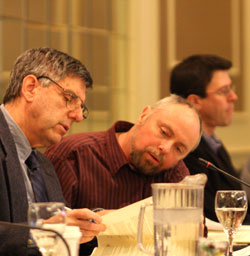 Allocations was the topic at the NEFMC meeting in Danvers, MA. That meant diving into and wading through acronyms—ACL, CDQ, OFL, ABC, MSY, EIS, AND BLT’S. David Goethels, right, NEFMC, turns to look at the 120 page technical memorandum for the day. Sam Murfitt photo Allocations was the topic at the NEFMC meeting in Danvers, MA. That meant diving into and wading through acronyms—ACL, CDQ, OFL, ABC, MSY, EIS, AND BLT’S. David Goethels, right, NEFMC, turns to look at the 120 page technical memorandum for the day. Sam Murfitt photo
|
Vito Giacalone said, Currently, NMFS is responsible for tracking hundreds of permits. With the sector system, he said, each sector would be responsible for its own plan, and would report to NMFS, relieving the agency of a significant administrative burden.
While the council is operating under an Amendment 16 deadline, it is still very much up in the air whether this deadline can be met. A complicating factor is that there will be a mid-term adjustment based on the stock assessment, and some fear the numbers will not be good. If the council doesn’t have something in place by then, the NMFS will cut effort with DAS.
Sectors are seen as the only thing close to being on the table with any chance of salvaging some of the fishery for the small operator fishermen. Some fishermen described NMFS as having another agenda. Permitted fishermen in the Gulf of Maine would be more conveniently managed by NMFS if the current number, 1,200, were down to 400.
The DAS system has reduced fishing days to numbers that cannot sustain a fishing boat. Corporate fleet owners are allowed to buy DAS from those who can no longer hold on for a management plan that includes them. Jacky O’Dell of the Northeast Seafood Coalition spoke to the oversight committee about the “large number of fishermen who have taken on enormous debt” in an effort wait out a solution.
The process of management change is slow, deadly slow. Terry Stockwell, DMR, described the process as being “as slow as metal rusting.” Fishermen charged management with wasting its time micromanaging the fisheries.
NMFS is opposed to attempts to have a sector plan in place for 2009 on the grounds that it has neither the staff nor the money to develop it. NMFS reps pointed out that they would be required to track the histories of all sector members. There are 19 sectors proposed—cod, haddock, hook, etc., and 19 species. While that would clearly require staff and number crunching, some have accused the agency, NMFS, of foot dragging.
The NEFMC has been reluctant to go into any plan with a hard total allowable catch (TAC) or quotas, for fear of the inevitable consolidation of fishing access. The council and NMFS being at odds has been frustrating for both the council and the fishermen.
At the oversight committee meeting, a preparation for the council meeting the following week, Joel Hovansian, a Rhode Island fisherman, said he has been to too many meetings that don’t get beyond arguments between the NMFS regional administrator and the council. “We need to get away from micromanaging, there are five acronyms used for each stock,” said Hovansian.
In attempting to attach numbers to allocation plans the use of five acronyms was a conservative estimate. The complexity of the terms used to describe stock management seems to snowball in the briefest of presentations.
The council will be bring proposals to the February meeting in Portsmouth, N.H. where a final vote will be taken on whether the council will move forward with a sector plan for the May, 2009 implementation date. Not all council members, who are in the fishing business, agree that the attempt to meet the 2009 deadline, rather than wait until 2010 is worth the effort, or possible. The fishermen most likely to lose their boats and businesses do.
How the agency responds in February may undermine the council’s efforts.
|





